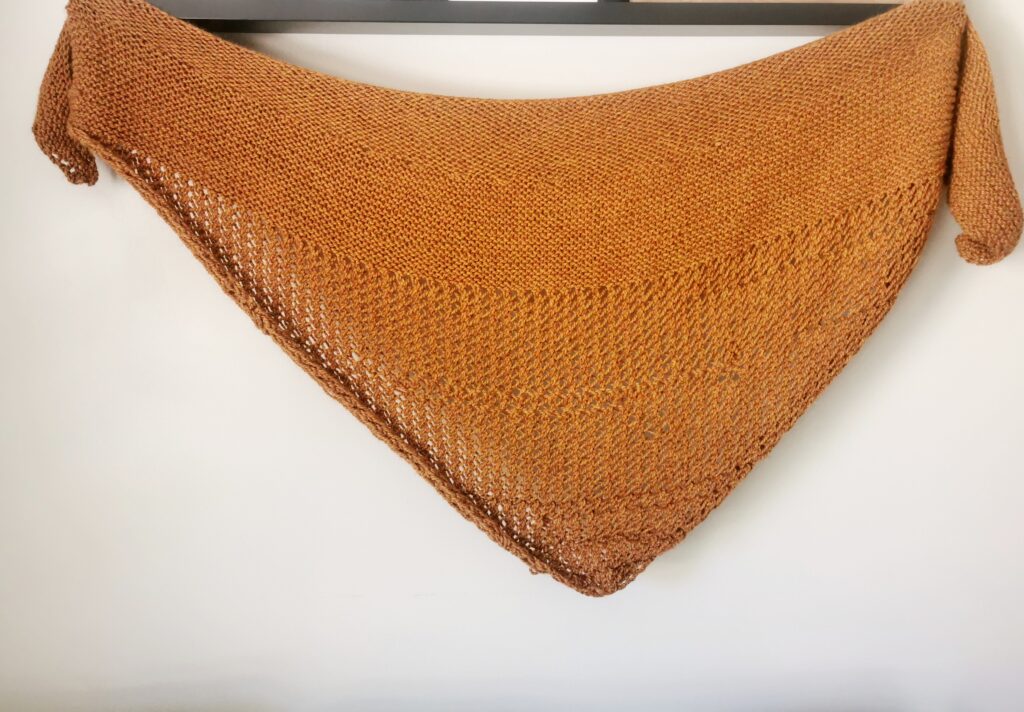Sharing approaches to anti-oppressive practice (part 1)
Conversations
We invited authors Hannah Taylor-Johnson, Kim Valldejuli and Lesli-Ann Belnavis Elliott to share their approaches to anti-oppressive art therapy practice by asking each other questions about their recent articles, published in the International and Canadian journals of art therapy.
First, Kim and Lesli-Ann put their questions to Hannah, whose paper explores knitting as a way of honouring Black ancestry and creating storytelling through community, belonging and reframing guilt.

In the experience and investigation of knitting, did you come across any oral or written history that connects the practice of knitting to community and ancestry? If so, did this strengthen or support the embodiment of the author’s experience more?
Kim and Lesli-Ann
Hannah: The exploration of knitting and wellbeing examined community and grief in relation to Black identity. There were themes of embodiment and ancestral consideration throughout. My research looked at printed histories, but I think it is important to also name the less acknowledged histories I came across and to share the thread of thought that started the project and saw it through to its conclusion.
This paper was born during the end-of-life of my father. I knitted during this time, and my aunts often took the yarn from me. There were gentle chastisements and teasing about the technique I used, how much I’d spent on yarn, did I know about this shop over there that would sell it cheaper, and, ‘what was the pattern again?’ There were stories about how my dad’s sister would spend late nights knitting jumpers for my cousins in the run up to Christmas, leading to stories about how cold England was when they arrived.

In this regard, it was less an oral history. It was a type of present history being weaved into the fibre of my own story with the intersects of my dad’s story, and a way of connecting to my broader paternal family. This first shawl, knitted at my father’s bedside, documented a type of oral history gained during this time of family bonding.

After that, I did some immersive research with the goal of replicating the knitting pattern. I found of women devoting their knitting and knowledge to others who had taught them the same freedom of expression that comes with fibre arts. For example, this excerpt from Collier (2013)
I sat there knitting fervently by your bedside, first waiting for you to recover, and then waiting for you to cross over, I knew whenever you looked up and saw me that we both silently acknowledged the (…) women before us that had done the same thing (…). And I, as with the women before me, will now wear this (…) with sad, sweet, and grateful memories of everything you have been in my life, felted into the very fibre with tears. I am reminded, once again, that this is why women need to create with fibers while participating in the process of life.
Colliers, 2013
I read about womanism – a Black feminist movement that focuses on issues specific to Black women, inclusive of Black men, and Black families and the shared community love of resource sharing. And I found stories of managing racism in the work of crochet artists, in addition to reasoning behind the devaluing of fibre arts. There’s a history of dismissing and devaluing art making that can be fit around life, that can be undertaken while rearing children, that offers sustenance and fulfils a physical need. Fibre arts, especially, are often not seen as ‘real’ art.
However, if we look at the story, the symbolism and the freedom of knitting, we can see how beautiful it is. How technical, how skilled, how loving the art form can be. It was hard to find specific research on these feelings in relation to fibre because no one speaks of the remarkable things that occur in day-to-day moments. I had to search for work and research outside the field of art therapy. All of this left me quite frustrated. I thought of the hours I’d poured into my first piece, the love and joy and grief it contained. I wondered how many other pieces exist in the world with their stories detached from the blanket, the scarf, or the mittens.
As I created the shawl for this research, I thought constantly about the fact that nothing I did was new. I felt connected to the women who had come before me, who had explored this work in varying ways. I thought of the grand love and care and kindness that has been repeated over the centuries. And I felt embodied not just within myself but as part of a larger collective.
Was there symbolism in doing an art activity that was ‘slow’ and if so did you find that it resonated with taking care of the spirit and pausing?
Kim and Lesli-Ann
Hannah: When we experience life’s larger intensities, there’s a tendency to forget that momentary feelings aren’t necessarily the same feelings that resound over time and space.
Creating a project that spanned different bodily states, relational interactions and life backdrops allowed me to capture the small moments and shape it into something that summarised the experience rather than a passing hour or day. I replicated the shawl I created during my father’s passing alongside friends and colleagues for this exploration. After each knitting session, I created 2D art in a journal used as a way of reflecting on the process once the shawl was completed.
This work borders a spiritual experience, in that it holds a deeply personal and profound meaning for me. It also extends beyond me and into an intangible understanding of spirituality, ancestry and communion. Moving slow allowed me to explore that, and, better yet, it permitted me space to connect on a deeper emotional level to community and peoples who may have a different relationship with the concept of spirit.
The slowness allowed me to feel love very deeply, from small road trips with my spouse to buy new yarn, to conversations with friends around the globe. ‘Slow’ allowed me to exhale first, making room in the tenderest spaces, inhaling to fill the ache of grief with new breath, and to ensure I really felt those moments of connection and community that soothed me.
Moving slow with the investigation also left me feeling connected to something larger both in an obvious way and an indirect ancestral manifestation. Creating this work was a labour of love, both in the community that poured into me while making it, but also in the reflections of ancestral and historical labouring. I wondered about opportunities others had accessed before me to move slowly, to create just for the joy of creating and not because of financial restraint, pragmatic necessity or capitalism. I sat in the ideas of labouring with the ancestral histories I have as a working-class, Black Caribbean – White British multiracial woman, with a lineage of global movement (some more enforced than others).

In your article you say this work weaved in micro and macro aggression you experienced. What macro/microaggressions did you face?
Kim and Lesli-Ann
This is a hard question.
Honestly, there is a deliciousness in describing these incidents that comes from the empowerment of now being in a position of being able to speak wholly and authentically.
However, my instinct isn’t to solely focus on the harm I received. There’s a time and a place for that and it doesn’t feel right to detail it here. If you hold an identity vulnerable to aggressions, then you’ll know it’s a constant stress to navigate the blows. You’ll know it on a deep-felt level. But to describe it in excruciating detail does those who experience it personally a disservice, and it feels performative to a gaze that I don’t wish to perform to.
Instead, I’d prefer to tell you how I experienced micro and macro love throughout this work. To counter the weighty racism, the disparaging and dismissive handling of this work, I allowed myself to be held so beautifully by my community.
Black women often have a community of folk who help vet, proof and review tone and intent in communication to those who may not see the sender as a whole person. And in this situation, as a biracial woman, I was no different. My community is made up of many folks, all of whom I hold in deep gratitude, but especially those Black women who saw the pain as a mirrored version of their own experience with their ‘me too’, their anger, and their compassion.
As I researched knitting, Blackness, art therapy and navigating these spaces, I felt consistently alone with my voice and concepts, until I stumbled on beautiful, raw writings on womanism in art therapy spaces like those of Leah Gipson. These readings were monumental in bolstering me and reassuring me that I was on the right path. The micro and macro aggressions of the field were sometimes so unintentional that it was clear they were woven into the very fabric of the practice. It has consistently felt like love to find other art therapists who say ‘me too’, ‘this doesn’t feel ok’, and ‘let me do this a different way’.
There were times during this research that I had to fight to write to the audience I envisioned, an audience that would have the ‘common knowledge’ baseline already. I had to steel myself for eye rolls, or being told that I am aggressive when I asserted a need.
When I say that I didn’t create this paper alone, what I mean is that I’ve always been surrounded by micro and macro demonstrations of love. These come in the form of soft landings, proof reading, validation and reassurance in order to counter the micro and macro aggressions I faced creating a career and an understanding of art that comes from a Black-centric way of being. I was guided and supported in ‘what do we let slide to get through this’, and ‘what do we unfurl ourselves for?’
And when I look at the knitting, when I feel the softness of this shawl, I don’t necessarily remember the failings of those who refused to see me or the work I was doing. Instead, I see and feel those people who sat with me as I did the work that spoke from my soul, as I navigated feelings of not belonging, and as I stood on the outskirts of a new-to-me community I felt so rejected from.
I am grateful to be building a new art and art therapy community; I am sad that I had to do it because no other seemed to exist; and I’m delighted that I was able to do so from the existing micro and macro acts of love. These acts of love were so powerfully evident in a pre-established community that they bolstered me as I entered a new field, and as I moulded a community into what I envision for people that look and feel like we do.
With thanks
I’d like to take a moment to extend my deepest gratitude to Irma Lewis, my aunt, who was simply so excited to discuss this knitting project and see it published. And, as always, I have everlasting gratitude to my father, Enric Johnson. Without either of you, there wouldn’t have been a shawl to investigate. You both make the most beautiful ancestors.
References
- ‘Knitting as a way of honoring Black ancestry and creating storytelling through community, belonging, and the reframing of grief: a womanist perspective’ Taylor-Johnson, H, Canadian Journal of Art Therapy (2023)
Read part 2
In our autumn issue, Hannah put her questions to Kim and Lesli Ann about their article calling for a more robust intersectional approach in art therapy training.


